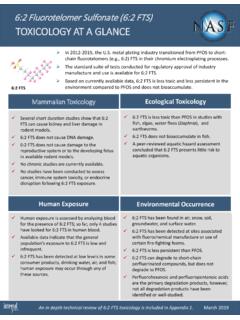Transcription of Draft Method 1633 Analysis of Per- and Polyfluoroalkyl ...
1 Draft Method 1633 - subject to revision August 2021 Office of Water August 2021 Draft Method 1633 Analysis of Per- and Polyfluoroalkyl Substances (PFAS) in Aqueous, Solid, Biosolids, and Tissue Samples by LC-MS/MS Draft Method 1633 - subject to revision August 2021 Environmental Protection Agency Office of Water (4303T) Office of Science and Technology Engineering and Analysis Division 1200 Pennsylvania Avenue, NW Washington, DC 20460 EPA 821-D-21-001 Draft Method 1633 - subject to revision August 2021 Draft Method 1633 Analysis of Per- and Polyfluoroalkyl Substances (PFAS) in Aqueous, Solid, Biosolids, and Tissue Samples by LC-MS/MS August 2021 Notice This document represents a Draft of a PFAS Method currently under development by the EPA Office of Water, Engineering and Analysis Division (EAD), in conjunction with the Department of Defense (DOD). This Method is not required for Clean Water Act compliance monitoring until it has been proposed and promulgated through rulemaking.
2 A single-laboratory validation of the procedure has been completed and the report on the results of that study is being prepared. Historically, EAD posts Draft methods on the Clean Water Act website after the single-laboratory validation report is completed. However, due to a large number of public and stakeholder requests, this Method is being posted on the web before the single-laboratory validation study report is finalized. A revision of this Draft Method with a later publication date may be issued at that time. No procedural changes are expected as a result of t he single-laboratory validation, but some of the performance data (which are presented only as examples) may change once the statistical Analysis of the single-laboratory validation data is completed. This Draft Method has been subjected to multiple levels of review across several EPA Program Offices. DOD expects to begin a multi-laboratory validation study of the procedure in late 2021, in collaboration with the Office of Water and the Office of Land and Emergency Management.
3 The Office of Water will use the results of the multi-laboratory validation study to finalize the Method and add formal performance criteria. The Method validation process may eliminate some of the parameters listed in this Draft Method . In the meantime, the Office of Water is releasing this Draft on its web site. Laboratories, regulatory authorities, and other interested parties are encouraged to review the Method , and where appropriate, utilize it for their own purposes, with the explicit understanding that this is a Draft Method , subject to revision. Draft Method 1633 - subject to revision i August 2021 Acknowledgements This Draft Method was prepared under the direction of Adrian Hanley of the Engineering and Analysis Division, Office of Science and Technology, within EPA s Office of Water, in collaboration with the Department of Defense. EPA acknowledges the support of a number of organizations in the development and validation of this Draft Method , including the developers of the original procedure, the Department of Defense, the members of EPA s workgroup, and EPA s support contractor staff at General Dynamics Information Technology, including: Adrian Hanley EPA Office of Water, Office of Science and Technology, Engineering and Analysis Division S.
4 Bekah Burket EPA Office of Water, Office of Science and Technology, Engineering and Analysis Division Troy Strock EPA Office of Land and Emergency Management Diane Reese EPA Region 4 Steve Reimer EPA Region 10 Janice Willey Department of Defense, Naval Sea Systems Command Richard H. Anderson Department of Defense, Air Force Civil Engineer Center Allyson Buytendyk Institute for Defense Analysis Coreen Hamilton SGS-AXYS Analytical Ivona Zysk SGS-AXYS Analytical Ting Chen SGS-AXYS Analytical Henry Huang SGS-AXYS Analytical Mirna Alpizar General Dynamics Information Technology Harrry McCarty General Dynamics Information Technology Disclaimer See the notice on the title page regarding the status of this Method . Mention of trade names or commercial products does not constitute endorsement or recommendation for use. Contact Please address questions, comments, or suggestions to: CWA Methods Team, Engineering and Analysis Division (4303T) Office of Science and Technology Environmental Protection Agency 1200 Pennsylvania Avenue Washington, DC 20460 Draft Method 1633 - subject to revision ii August 2021 Table of Contents Acknowledgements.
5 I Disclaimer .. i Contact .. i Scope and Application .. 1 Summary of Method .. 1 Definitions .. 2 Contamination and interferences .. 2 Safety .. 3 Equipment and 5 Reagents and standards .. 8 Sample collection, preservation, storage, and holding times .. 13 Quality Control .. 14 Calibration and Standardization .. 18 Sample preparation and extraction .. 25 Extraction, Cleanup, and Concentration .. 30 Instrumental Analysis .. 32 Performance Tests during Routine Operations .. 33 Data Analysis and Calculations .. 35 Method Performance .. 38 Pollution Prevention .. 38 Waste Management .. 39 References .. 39 Tables, Diagrams, Flowcharts, and Validation Data .. 41 Glossary .. 55 Appendix A - Sample Pre-screening Instructions .. 59 Appendix B - Aqueous Sample Subsampling Instructions .. 60 Draft Method 1633 - subject to revision 1 August 2021 Draft Method 1633 - Analysis of Per- and Polyfluoroalkyl Substances (PFAS) in Aqueous, Solid, Biosolids, and Tissue Samples by LC-MS/MS Scope and Application Method 1633 is for use in the Clean Water Act (CWA) for the determination of the per- and Polyfluoroalkyl substances (PFAS) in Table 1 in aqueous, solid (soil, biosolids, sediment) and tissue samples by liquid chromatography/mass spectrometry (LC-MS/MS).
6 The Method calibrates and quantifies PFAS analytes using isotopically labeled standards. Where linear and branched isomers are present in the sample and either qualitative or quantitative standards containing branched and linear isomers are commercially available, the PFAS analyte is reported as a single analyte consisting of the sum of the linear and branched isomer concentrations. The instrumental portion of this Method is for use only by analysts experienced with LC-MS/MS or under the close supervision of such qualified persons. Each laboratory that uses this Method must demonstrate the ability to generate acceptable results using the procedure in Section By their very nature, many components of PFAS present analytical challenges unique to this class of analytes. For example, PFAS analytes readily adhere to the walls of the sample containers and may also stratify in the container.
7 EPA has included procedures in the Method that must be employed to address such challenges (see Section and Appendices A and B). This Method is performance-based, which means that modifications may be made without additional EPA review to improve performance ( , overcome interferences, or improve the sensitivity, accuracy, or precision of the results) provided that all performance criteria in this Method are met. Requirements for establishing equivalency are in Section and include For CWA uses, additional flexibility is described at 40 CFR Changes in performance, sensitivity, selectivity, precision, recovery, etc., that result from modifications within the scope of 40 CFR Part , and Section of this Method must be documented, as well as how these modifications compare to the specifications in this Method . Changes outside the scope of 40 CFR Part and Section of this Method may require prior review or approval.
8 Summary of Method Environmental samples are prepared and extracted using Method -specific procedures. Sample extracts are subjected to cleanup procedures designed to remove interferences. Analyses of the sample extracts are conducted by LC-MS/MS in the multiple reaction monitoring (MRM) mode. Sample concentrations are determined by isotope dilution or extracted internal standard quantification (see Section ) using isotopically labeled compounds added to the samples before extraction. Extraction Aqueous samples are spiked with isotopically labeled standards, extracted using solid-phase extraction (SPE) cartridges and undergo cleanup using carbon before Analysis . Solid samples are spiked with isotopically labeled standards, extracted into basic methanol, and cleaned up by carbon and SPE cartridges before Analysis . Draft Method 1633 - subject to revision 2 August 2021 Tissue samples are spiked with isotopically labeled standards, extracted in potassium hydroxide and acetonitrile followed by basic methanol, and cleaned up by carbon and SPE cartridges before Analysis .
9 This Method measures the analytes as either their anions or neutral forms. The default approach for Clean Water Act uses of the Method is to report the analytes in their acid or neutral forms, using the equations in Section , although the differences between the anion and acid form concentrations are minimal (See Table 8). Other project-specific reporting schemes may be used where required. Individual PFAS analytes are identified through peak Analysis of the quantification and confirmation ions, where applicable. Quantitative determination of target analyte concentrations is made with respect to an isotopically labeled PFAS standard; the concentrations are then used to convert raw peak areas in sample chromatograms to final concentrations. Results for target analytes are recovery corrected by the Method of quantification ( , either isotope dilution or extracted internal standard quantification, see Section ).
10 Isotopically labeled compound recoveries are determined by comparison to the responses of one of seven non-extracted internal standards ( , the recovery standards) and are used as general indicators of overall analytical quality. The quality of the Analysis is assured through reproducible calibration and testing of the extraction, cleanup, and LC-MS/MS systems. Definitions Definitions are provided in the glossary at the end of this Method . Contamination and interferences Solvents, reagents, glassware, and other sample processing hardware may yield artifacts and elevated baselines causing misinterpretation of chromatograms. Specific selection of reagents and solvents may be required. Clean all equipment prior to, and after each use to avoid PFAS cross-contamination. Typical cleaning solvents used include water, methanol, and methanolic ammonium hydroxide. The residual PFAS content of disposable plasticware and filters must be verified by batch/lot number and may be used without cleaning if PFAS levels are less than half the Minimum Level (ML, see Table 6).












